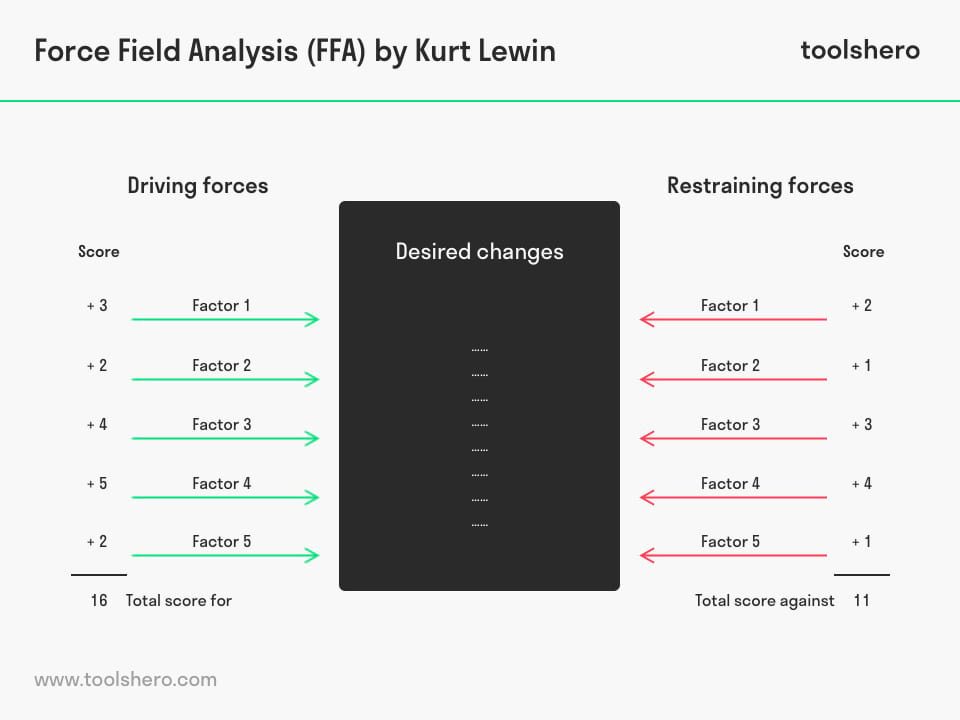Force Field Analysis by Kurt Lewin explained

Force Field Analysis: this article explains the Force Field Analysis by Kurt Lewin in a practical way. Next to what it is, this article also highlights the change process, the Force Field Analysis, an example template overview to start yourself, the possible obstacles and preconditions. After reading you will understand the basics of this powerful decision making tool. Enjoy reading
What is change? Kurt lewin’s Theory
In the last century, Kurt Lewin was best known for being the founder of social psychology. He proved that individuals not only have to deal with inner urges such as desires, motives, and expectations but also with pressure from their environment.
In his Change Management Model, he indicated that it is possible for individuals to be flexible and that they can change their behaviour. This does not happen overnight. Kurt Lewin identified three basic stages: the unfreezing stage, the change stage and the refreezing stage.
Change process
The first stage is about people becoming aware of their own behaviour and that they have to get rid of unwanted habits. Efforts should be made to transition from ‘unconscious wrong’ behaviour to ‘conscious wrong’ behaviour.
Only when individuals are aware of their ‘wrong ’behaviour it is possible to move to the second stage. In the move stage it is important for individuals to acquire the required appropriate knowledge, attitudes and skills. Efforts should be made to transition from ‘conscious wrong’ to ‘conscious right’ activities.
In the third and final stage the desired (new) behaviour cannot be a once-only occurrence but the aim is that this will become(and remain) a fixed part and pattern of their daily routine. The ideal is a continuous transition from ‘conscious good’ to ‘unconscious good’.
Force Field Analysis
Change is very difficult to accept for people and they would much rather see that everything remains ‘the same’. This also applies to companies and organizations where it is important to implement changes.
After all, inertia is tantamount to decline and in order to generate as little resistance as possible, Kurt Lewin developed the Force Field Analysis (FFA). This is a method in which a team or an organization can predict in advance what the expected resistance will be to the proposed change.
Change within an organization can be effected in different ways. For example a reorganization, the introduction of a new technology, introduction of new machines, adjustment of production or changes in work processes. Using FFA, it becomes clear what forces could possibly influence the change.
These might include resistant people, inoperative processes and structures, negative attitudes, habits, insufficient knowledge and skills. All these force may have an impact on the individual employee, a department or the entire organization.

Figure 1 – an example template of a Force Field Analysis
Force Field Analysis and possible obstacles
FFA is a powerful strategic instrument that is used to understand what is needed for change to take place in both a business and a personal environment. FFA makes clear what the possible obstacles are that could hinder change.
It enables an organization to become aware of the difficulties that may be involved in the envisaged change. By consulting thoroughly with each other, FFA ensures that teams will feel responsible. They will be better able to implement the change and to identify and eliminate any obstacles prematurely.
Driving and restraining forces
FFA distinguishes driving forces and restraining forces. The restraining forces are obstacles that get in the way of change. They have an impact on the change and they will try to restrain this. The driving forces support change and encourage positive effects.
FFA can be used as a tool to understand why, for example, the introduction of a new working method does not work which makes it possible to draw up an improvement plan. The FFA also contributes to the improvement of internal communication.
Preconditions Force Field Anaylsis
It is important that a Force Field Analysis group is composed of people in the organization that are involved in change in different ways. Preferably, this should be a differentiated group that includes manager, employees, internal clients and technicians.
This diversity is important because this makes it possible to look at the change and possible obstacles from different angles. Important stakeholders such as shareholders or clients can also be involved in a FFA group.
Now It’s Your Turn
What do you think? What is your experience with decision making and managing organizational change? Do you recognize the brief explanation on the Force Field Analysis or do you have any additions to this post? What are your success factors on decision making in relation to organizational change?
More information
- Baulcomb, J. S. (2003). Management of change through force field analysis. Journal of nursing management, 11(4), 275-280.
- Bozak, M. G. (2003). Using Lewin’s force field analysis in implementing a nursing information system. CIN: Computers, Informatics, Nursing, 21(2), 80-85.
- Lewin, K. (1946). Force field analysis. The 1973 Annual Handbook for Group Facilitators, 111-13.
- Schein, E. H. (1996). Kurt Lewin’s change theory in the field and in the classroom: Notes toward a model of managed learning. Systemic Practice and Action Research, 9(1), 27-47.
- Thomas, J. (1985). Force field analysis: A new way to evaluate your strategy. Long range planning, 18(6), 54-59.
How to cite this article:
Mulder, P. (2017). Force Field Analysis (Lewin). Retrieved [insert date] from Toolshero: https://www.toolshero.com/decision-making/force-field-analysis/
Original publication date: 05/03/2017 | Last update: 11/15/2023
Add a link to this page on your website:
<a href=”https://www.toolshero.com/decision-making/force-field-analysis/”>Toolshero: Force Field Analysis (Lewin)</a>












